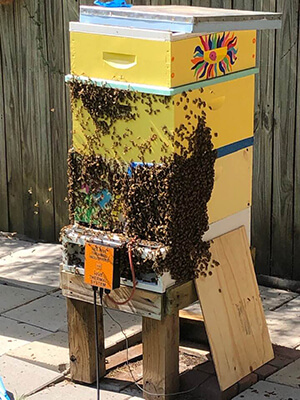
Thermal hive treatments could help control varroa without using chemicals, but many questions remain
The honey bees were becoming increasingly irritated. That day, they were getting a heating device installed in their hive, and they weren’t happy about it. As Darwyn Flynn — a beekeeper in Paris, Texas — powered up the device, the hive started to become a sweltering sauna. The bees first focused on fanning the entrance, but soon started to leave the hive altogether. More and more bees marched out, quickly forming a thick beard on the front of the colony. The scene reminds me of when someone pulls a fire alarm in an office building. Only here, there was not a fire, but a slow, deliberate heating of the hive with one goal in mind: killing mites.
The hive heating device is called the Mighty Mite Killer, manufactured by Bee Hive Thermal Industries. The device slides into the hive base and, connected to a 110 V power supply, it raises the internal hive temperature (controlled by thermistors) into the “mite-kill” range (104-106.7 degrees Fahrenheit, or 40-42 degrees Celsius). The manufacturer recommends maintaining this temperature for 2 hours and 40 minutes for the best results, and each unit runs at about $300 (battery not included). But as Flynn points out, saving just one hive that would otherwise perish pays it back.
“According to my reading, this product shouldn’t work,” says Flynn. He was running a test to try to reconcile why his own experience with the device conflicts with the conventional wisdom: that heat is bad for bees. Laboratory experiments have shown that heat stress at temperatures identical to the mite-kill range also kills drones and can lead to queen failure. Moreover, beekeepers and researchers alike worry that the heat treatment could cause developmental abnormalities or death of the brood.
But ten days after Flynn’s thermal test, this hive was thriving with a mite load of just 0.7%, down from 4.7%. All stages of brood were present, the adult population was strong, and the queen remained productive. “I have read a number of published studies indicating that harm would be done,” says Flynn. “What is absent in these lab settings is real life conditions.”
Flynn is right — a lot of the work that has been done on the adverse impacts of heat on queens, drones, and workers has been done in the lab. For example, in my own research (which is in the process of peer review), I have seen first hand that when queens are heat-stressed, the sperm stored in their spermathecae predictably start to die.1,2 But in my experiments, I heated queens in small cages to mimic the conditions during queen shipments, which is not the same as heating a whole hive. In a hive, we don’t yet know if the queen is protected from heat, but theoretically, she could be — maybe she moves to a cooler cranny, maybe she is fanned or heat-shielded by workers, or maybe she even exits the hive herself (although the latter might be a risky strategy). The drones, too, may simply exit the hive to avoid death or partial sterilization. We just don’t know.
“Thermal treatments are becoming very popular in Europe,” says Lynn Williams, the president of Bee Hive Thermal Industries. “In the U.S., we have been on a chemical track since varroa arrived.” Reducing dependency on acaricides is probably the biggest motivator for developing thermal mite treatments. But other benefits include that the treatment kills mites in capped brood cells and that it can be performed even while there is a honey crop on the hive. The website lists simultaneous control of small hive beetle as an added perk, but I have trouble reconciling that with other research showing that small hive beetles happily lay eggs even when held at 104 F (40 C) for 24 hours (although granted, not as many as they would at optimal temperatures).3 Williams agrees that large-scale field studies still need to be done, and there has been very little formal testing on potential side effects of the treatment. But he notes that the pilot studies have shown promising results. He says, with some frustration bleeding through, that the technique has been “largely ignored” in the U.S. “There is a severe lack of education of thermal technology to manage varroa. It is actual product users who are doing the education and they are limited in scientific data to share.”
Some people, like Scott Davis — a beekeeper in North Carolina — are determined to produce the data themselves. Davis is pursuing his Master Craftsman designation and as part of that, he is working closely with Professor David Tarpy to design and execute a field experiment to see if hive thermal treatments impact drone sperm viability. “There’s plenty of research on the heat treatment and its effects on mites,” Davis says. “From the data I’ve seen, it does appear to work. My concern with this and similar treatments is: Do we really know the extent of what happens to the hive and the brood?”
Davis plans to execute the trial in the summer of 2020, and is not affiliated with Bee Hive Thermal Industries. In his project, he is focused on studying ….


